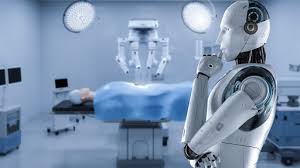The healthcare industry has been rapidly evolving, with technological advancements playing a pivotal role in shaping the future of patient care. One of the most revolutionary changes in healthcare is the introduction and increasing use of robots. From robotic surgery to robotic-assisted rehabilitation, robots are becoming integral in various aspects of healthcare, offering both promising benefits and challenges. As healthcare providers strive to enhance treatment outcomes, improve efficiency, and reduce costs, robots offer a range of solutions. However, their integration into healthcare systems brings forth certain risks that must be carefully considered.
In this article, we will explore the key benefits and risks of using robots in healthcare, shedding light on how these innovations are transforming the industry and what challenges they may present.
Benefits of Using Robots in Healthcare
1. Improved Precision and Accuracy
Robots, especially in surgical settings, offer unparalleled precision and accuracy that human hands alone may not be able to achieve. Robotic systems, such as the da Vinci Surgical System, have revolutionized minimally invasive surgery by allowing surgeons to perform complex procedures with greater control and precision.
- Minimally Invasive Surgery: Robotic-assisted surgery often involves smaller incisions, which result in less trauma to the body, faster recovery times, and a reduced risk of complications.
- Higher Accuracy: Robotic systems can guide surgeons with precision, reducing the likelihood of errors that could occur in delicate or complicated procedures.
2. Enhanced Efficiency and Productivity
Robots can perform repetitive tasks with greater efficiency than humans, making them valuable tools in healthcare settings where time and productivity are crucial. Automated processes allow healthcare professionals to focus more on direct patient care and complex tasks.
- Task Automation: Robots can assist with routine and repetitive tasks such as dispensing medication, sterilizing equipment, and transporting supplies, allowing healthcare workers to allocate more time to patient care.
- Reduced Wait Times: Robotic systems can help expedite various medical processes, from diagnostic testing to surgery, reducing patient wait times and improving overall hospital workflow.
3. Minimizing Human Error
In healthcare, human error can have serious consequences, especially in critical care or surgical environments. Robots can minimize human errors by following precise instructions and performing tasks consistently without fatigue, which can reduce the likelihood of mistakes.
- Accuracy in Medication Dispensation: Robots can be programmed to dispense medication accurately, reducing the chances of errors that could arise from human oversight or misinterpretation of prescriptions.
- Reduced Fatigue-Related Errors: Unlike human workers, robots do not suffer from fatigue, which is particularly important during long shifts or complex medical procedures.
4. Better Patient Outcomes
Robotic technology has the potential to improve patient outcomes by enhancing the quality of care and reducing the risks associated with medical procedures. With robotic systems offering greater precision, reduced human error, and faster recovery times, patients are likely to experience better treatment outcomes.
- Faster Recovery: Robotic surgeries, such as those using minimally invasive techniques, result in less trauma to the body, leading to faster healing times and shorter hospital stays for patients.
- Reduced Risk of Infection: With robotic surgery, smaller incisions are often made, reducing the risk of post-operative infections and complications associated with large wounds.
5. Accessibility to Remote Areas
Robots can help address healthcare access issues, particularly in rural or underserved areas where access to skilled medical professionals may be limited. Telepresence robots allow specialists to consult with patients remotely, while robotic surgery enables skilled surgeons to operate from a distance, even in locations with fewer healthcare resources.
- Telemedicine and Remote Consultations: Through robotic systems, patients in remote areas can benefit from the expertise of specialists without needing to travel long distances.
- Global Collaboration: Robotic systems allow healthcare professionals from around the world to collaborate on complex cases, providing patients with access to expertise that might otherwise be unavailable.
6. Robotic Rehabilitation and Therapy
In rehabilitation settings, robots can play a significant role in helping patients regain mobility and strength after injuries or surgeries. Robotic-assisted therapy can provide targeted and precise movements, which may be difficult for human therapists to replicate consistently.
- Improved Physical Therapy: Robotic devices, such as exoskeletons, can help patients with mobility impairments to regain movement and strength in a controlled manner, often improving the success of physical therapy programs.
- Personalized Treatment: Robots can be programmed to deliver therapy tailored to the patient’s needs, ensuring more consistent and effective rehabilitation.
Risks of Using Robots in Healthcare
1. High Initial Costs and Maintenance
While robots offer numerous advantages, the initial cost of purchasing and maintaining robotic systems can be prohibitively high for many healthcare institutions. This can limit the widespread adoption of robotic technology, particularly in smaller or budget-constrained healthcare settings.
- Initial Investment: The cost of robotic surgical systems, rehabilitation devices, and other healthcare robots can run into millions of dollars, making it a significant financial commitment.
- Ongoing Maintenance: Robotics systems require regular maintenance, which can add to the operational costs. This includes software updates, technical support, and repairs, which could create financial strain for healthcare facilities.
2. Dependence on Technology and Malfunctions
One of the major risks of incorporating robots into healthcare is the potential for technological failures. Malfunctions in robotic systems could lead to disruptions in patient care, and in critical situations, they could pose significant risks to patient safety.
- System Failures: If a robot malfunctions during a surgical procedure or therapy session, it could result in serious consequences. Although these systems are designed to be highly reliable, technical issues may still arise.
- Dependence on Automation: Over-reliance on robotic systems could reduce the ability of healthcare professionals to perform manual tasks in the event of a failure. Human intervention is still necessary to ensure that technology enhances care rather than replacing critical judgment.
3. Lack of Human Touch and Compassion
While robots can perform tasks efficiently and precisely, they lack the human touch that is essential in healthcare, particularly in providing emotional support and compassion to patients. The emotional and psychological well-being of patients is just as important as their physical health, and robots are not capable of building the human connection that patients may need.
- Reduced Empathy: Robots, no matter how advanced, cannot replicate the empathy, understanding, and compassion that human healthcare providers offer. This could lead to a less holistic patient experience.
- Patient Discomfort: Some patients may feel uncomfortable interacting with robots, particularly in scenarios where human touch and communication are essential, such as in end-of-life care or during sensitive medical procedures.
4. Privacy and Security Concerns
The integration of robots in healthcare raises significant concerns about patient data privacy and security. Since robots in healthcare often collect, store, and transmit sensitive patient data, there is an increased risk of breaches, data theft, and cyberattacks.
- Cybersecurity Risks: Robotic systems connected to healthcare networks are vulnerable to hacking and cyberattacks, which could lead to unauthorized access to patient records or tampering with medical data.
- Data Privacy: Robots equipped with sensors and AI may collect personal and medical data from patients. If not adequately protected, this information could be exposed or misused.
5. Job Displacement Concerns
The use of robots in healthcare raises concerns about job displacement for human workers. As robots become more capable of performing various tasks, there is the potential for reduced demand for certain healthcare roles, particularly in areas like surgery, rehabilitation, and patient care.
- Loss of Jobs: While robots can improve efficiency, they may also reduce the need for certain manual tasks performed by human healthcare workers, leading to job losses in some sectors.
- Reskilling and Workforce Transition: As robots take on more roles, there is a need for healthcare professionals to reskill and transition into new positions that complement robotic technology, such as overseeing robotic systems or interpreting robotic data.
6. Ethical Concerns
The use of robots in healthcare also raises ethical dilemmas, particularly in situations where robots might make decisions that could impact patient outcomes. Questions regarding the responsibility for errors or the use of robots in critical care situations must be carefully considered.
- Accountability: In the event of a robot malfunction or error, it may be difficult to determine who is responsible for the consequences. Is it the manufacturer of the robot, the healthcare provider, or the robot itself?
- Ethical Decision-Making: In some healthcare scenarios, decisions about patient care are complex and require human judgment, ethics, and emotional understanding. Robots may not be equipped to navigate these nuanced situations.
Conclusion
The integration of robots into healthcare offers a wide range of benefits, including improved precision, enhanced patient outcomes, increased efficiency, and better accessibility to healthcare. They also hold significant promise in areas such as robotic surgery, rehabilitation, and remote consultations, offering the potential to transform how care is delivered.
However, the use of robots in healthcare is not without its risks. The high initial costs, potential for system malfunctions, cybersecurity concerns, and ethical dilemmas are just a few of the challenges that need to be addressed. Additionally, robots cannot replace the emotional support and human connection that is integral to patient care.
As technology continues to evolve, it is essential to find a balance between the use of robotics to improve healthcare delivery and maintaining the vital human elements of care. With thoughtful implementation, proper regulation, and ongoing advancements, robots have the potential to significantly enhance the healthcare industry, but they must be used responsibly to ensure patient safety, privacy, and overall well-being.

